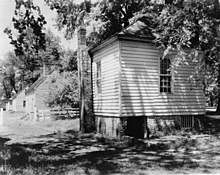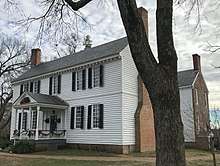Tuckahoe (plantation)
Tuckahoe, also known as Tuckahoe Plantation, is located in Tuckahoe, Virginia on Route 650 near Manakin, Virginia overlapping both Goochland and Henrico counties, six miles from the town of the same name. Built in the first half of the 18th century, it is a well-preserved example of a colonial plantation house, and is particularly distinctive as a colonial prodigy house. Thomas Jefferson is also recorded as having spent some of his childhood here. It was declared a National Historic Landmark in 1969.[2][4][5]
Tuckahoe Plantation | |
Tuckahoe plantation's southern wing | |
  | |
| Location | SE of Manakin near jct. of Rtes. 650 and 647, near Manakin, Virginia |
|---|---|
| Coordinates | 37°34′13.7″N 77°39′11.4″W |
| Area | 568 acres (230 ha) |
| Built | 1712 |
| Architect | William Randolph |
| Architectural style | Georgian, Other |
| NRHP reference No. | 68000049 |
| VLR No. | 037-0033 |
| Significant dates | |
| Added to NRHP | November 22, 1968[1] |
| Designated NHLD | August 11, 1969[2] |
| Designated VLR | November 5, 1968[3] |
History

Thomas Randolph first settled at Tuckahoe around 1714 and is recorded as contributing to the construction of the local Dover Parish (also known as St James Parish) church in the early 1720s.[6][7] William Randolph III, Thomas' son, constructed the current dwelling beginning in the mid-1730s. Dendrochronology analysis indicates the timbers in the older (north) wing date to ca. 1733 and this is supported by archaeological evidence dating the north porch to ca. 1740. The north wing features pine and black walnut paneling with exquisite carvings and moldings. William Randolph then added a center hall and south wing, creating a unique "H" shape which was completed by 1740. William and his wife, Maria Judith Page, had three children (two girls and Thomas Mann Randolph Sr. born 1741) but his wife died in 1744.[8] William Randolph's cousin Jane married Peter Jefferson, and they were close friends. Before William Randolph died in 1745, he added a codicil to his will asking that Peter Jefferson come to Tuckahoe Plantation and care for his three orphaned children.[9] The Jeffersons moved from Shadwell in Charlottesville to Tuckahoe Plantation with their three daughters and two-year-old son Thomas. While at Tuckahoe, Jane Randolph Jefferson gave birth to three more children of whom the two sons (both named Peter) died in infancy. The Jeffersons and Randolph orphans lived together in the "H"-shaped home until 1752.[10] Peter Jefferson directed the activities of the plantation and its seven overseers, "retaining a connection to the estate" even during his famous expeditions to map the western part of the state and after he returned to his own plantation of Shadwell.[11]
Thomas Mann Randolph Sr. and his wife Anne Cary had thirteen children and she died in 1789. Shortly afterward, Thomas Mann Randolph Sr. remarried to Gabriella Harvie, the seventeen-year-old daughter of a Richmond attorney. Gabriella made significant changes to Tuckahoe, including painting the wooden paneling in the so-called "White Parlor", and insisted on naming her son (b. 1792) Thomas Mann Randolph Jr. despite the fact that the eldest son of Thomas Mann Randolph and Anne Cary (b. 1768) was already named Thomas Mann Randolph Jr. Thomas Mann Randolph Jr./II (1768-1828) moved to Edgehill, Albemarle County, Virginia and went on to be a prominent statesman and governor of Virginia from 1819-1822. Thomas Mann Randolph Jr./III inherited Tuckahoe, but sold it for debts in 1830.
The house passed through several families in the mid-19th century, but returned to the Randolphs in 1898 when it was sold to Harold Jefferson Coolidge and a consortium of Randolph and Jefferson descendants. In the 20th century, Tuckahoe featured prominently in an early test of the National Historic Preservation Act when the owners challenged Virginia's plan to route Route 288 through the property (see Thompson v. Fugate, 347 F. Supp 120, E.D. Va. (1972)).
The house is currently occupied by owner/manager Addison B. Thompson and his wife Susan. The grounds are open for self-guided tours. The house is open for private tours by appointment and may also be rented for private events.
Exterior

The two-story wood structure sits in its original spot, the only Randolph home to not be relocated. The structure forms an "H," with wings mirroring each other and connected by a central corridor. The entrances to the house are reached by flights of stairs and two porches. The stoop is covered by a projected pediment supported by simple wooden posts and is framed by a wooden railing. To either side of the entrance is a pair of windows as well as a central window over the entrance, each with dark shutters. Each two-sashed window contains 9 panes of glass. The gabled roof rests on a simple cornice line with dentil moldings. A large brick chimney rises from either side of the home.
The grounds around the house include outbuildings: the schoolhouse where Thomas Jefferson was educated, a kitchen house, three slave quarters, smokehouse, storehouse, stable, and the cemeteries of the Randolph, Wight, and current Ball/Thompson families.
References
- "National Register Information System". National Register of Historic Places. National Park Service. January 23, 2007.
- "Tuckahoe". National Historic Landmark summary listing. National Park Service. Retrieved 2008-04-20.
- "Virginia Landmarks Register". Virginia Department of Historic Resources. Archived from the original on 2013-09-21. Retrieved 2013-03-12.
- James Dillon (October 9, 1974), National Register of Historic Places Inventory-Nomination: Tuckahoe Plantation (pdf), National Park Service and Accompanying 14 photos, aerial and exterior and interior, from 1968, 1972, and 1974 (32 KB)
- Charles W. Snell (March 19, 1971), National Register of Historic Places Inventory-Nomination: Tuckahoe Plantation House (Thomas Jefferson Boyhood Home) / Tuckahoe (pdf), National Park Service
- Glenn, Thomas Allen, ed. (1898). "The Randolphs: Randolph Genealogy". Some Colonial Mansions: And Those Who Lived In Them : With Genealogies Of The Various Families Mentioned. 1. Philadelphia, Pennsylvania: Henry T. Coates & Company. pp. 430–459.
- Tuckahoe Plantation Archived 2010-12-14 at the Wayback Machine
- Malone, Dumas, Jefferson the Virginian, St. Martin’s Press, 1948, Volume 1, p. 19
- Malone, p. 19
- Malone, pp. 20, 26
- Malone, p. 20, n48
Further reading
- Masson, Kathryn and Brooke, Steven (photographer); Historic Houses of Virginia: Great Plantation Houses, Mansions, and Country Places; Rizzoli International Publications; New York City, New York; 2006
External links

- Tuckahoe Plantation Website
- Tuckahoe, at National Park Service
- James River Plantations, a National Park Service Discover Our Shared Heritage Travel Itinerary
- Tuckahoe, Goochland County, 4 photos at Virginia DHR
- Historic American Buildings Survey (HABS) No. VA-712, "Tuckahoe Plantation, River Road, Richmond vicinity, Manakin vicinity, Goochland County, VA", 8 measured drawings

